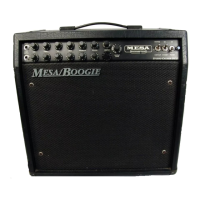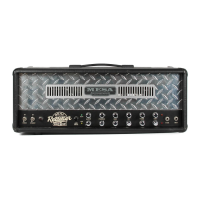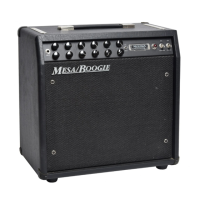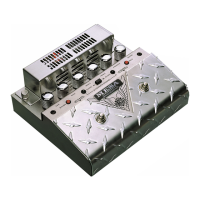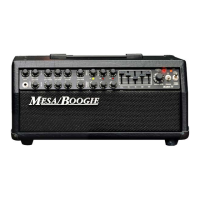filter with a turnover frequency that is set at approximately 25Hz. While HPF’s have been standard fare within the pro audio industry
for decades, this feature has only appeared in bass guitar amplifiers within the past few years (with some notable exceptions). This
filter provides additional mechanical protection to the speakers from over-excursion damage by reducing the power to the speaker
below the frequency range that the speaker cabinet provides adequate acoustic loading to the drivers. This is one of the primary
(and preventable) causes of premature speaker failure, especially with compact speaker cabinet products that are driven very hard.
A second use for this filter is to roll off the very low end when overdriving the amp. This prevents the signal from becoming muddy,
and preserves the naturally musical growl and grit of the overdriven signal. A third use is for rolling off the extreme low end when
boosting the bass eq control, allowing for some unique low mid voicings, and a fourth use is for reducing the sub-bass frequencies
that can get out of hand in a boomy room. Experimentation will be helpful in all of these applications.
BASS CONTROL:
This active eq control is responsible for the amount (or volume) of low frequencies present in the signal,
relative to the rest of the spectrum. Low frequencies (<80Hz) are responsible for the “depth”, “bottom”, “roundness”, or “feel” of the
tone. This is an active control with boost and cut, the amount of boost proportional to the clockwise rotation to the right of “flat” (12:00
straight up) position and the amount of cut proportional to the counter-clockwise rotation to the left of “flat” (12:00 straight up) position.
As with everything related to EQ, generally, a little bit goes a long way. The HIGH PASS FILTER control, combined with the BASS
CONTROL adds another dimension of tone sculpting by rolling off the extreme low end when boosting the bass eq control, allowing
for some unique low mid voicings. Use enough to get the job done and no more. Note that if you have very compact cabinets and
need high volumes, you will want to be aware that it is possible to overdrive speakers with excessive bass boost. If your speaker is
not getting you enough high level low end, it’s possible that you do not have enough “rig for the gig”, and “more speaker” is needed.
This is a shelving type filter.
TREBLE CONTROL:
This active eq control is responsible for the amount (or volume) of high frequencies present in the sig-
nal, relative to the rest of the spectrum. High frequencies (>2.5kHz) are responsible for the “bright”, “airy”, “shimmery” character of
the tone. This is an active control with boost and cut, the amount of boost proportional to the clockwise rotation to the right of “flat”
(12:00 straight up) position and the amount of cut proportional to the counter-clockwise rotation to the left of “flat” (12:00 straight up)
position. This is a shelving type filter.
PARAMETRIC MID EQ CONTROLS:
GAIN CONTROLS: These controls (bottom row) are responsible for the amount (or volume) of the corresponding LOW MID, MID
and HIGH MID midrange frequencies present in the signal, relative to the rest of the spectrum. (the center frequency of each band
is selected with the corresponding mid frequency control, top row). This is an active control with boost and cut, the amount of boost
proportional to the clockwise rotation to the right of “flat” (12:00 straight up) position and the amount of cut proportional to the counter-
clockwise rotation to the left of “flat” (12:00 straight up) position of. This is a peak-dip (or bell) style filter. Remember that a little eq
goes a long way, use just enough to get the job done.
FREQUENCY CONTROLS: These controls (top row) are responsible for selecting the center frequency (or pitch) that the correspond-
ing EQ GAIN controls acts on. Rotating this control sweeps the center frequency from lower (counterclockwise) to higher (clockwise).
If the eq gain control is set at 12:00 noon, there will be no effect when rotating the frequency control because there is no boost or
cut being performed. Sweep range varies by band, band 1: 80Hz – 1kHz, band 2: 150Hz – 2.5kHz, and band 3: 300Hz – 5kHz. The
frequency distribution of the sweep control is linear from endpoint to endpoint. It should be noted that these controls do not act on a
single frequency but act on a range of frequencies approximately 1/3 of an octave on each side of the center frequency.
PASSIVE MID CONTROL:
This eq control is an integral part of the amplifier’s voicing circuit and is responsible for the amount
of midrange frequency content present in the signal, relative to the rest of the spectrum. Midrange is primarily responsible for voic-
ing and articulation character of the instrument. This is a passive control with cut only, the amount of cut roughly proportional to the
counter-clockwise rotation of the control. Due to the specific way this filter is implemented by the use of make-up gain, most users
will find that their flat or neutral tone will be from the 10:00 to 2:00 position, and this might give the appearance of boost as the control
is rotated farther clockwise. This filter’s Q (width) symmetry and response is quite different from the parametric mid section, which is
typically used more for precise tuning of the amp’s response.
MASTER VOLUME CONTROL:
This control is responsible for the level of signal being sent to the power amp, and deter-
PAGE 4
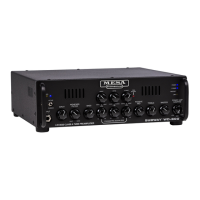
